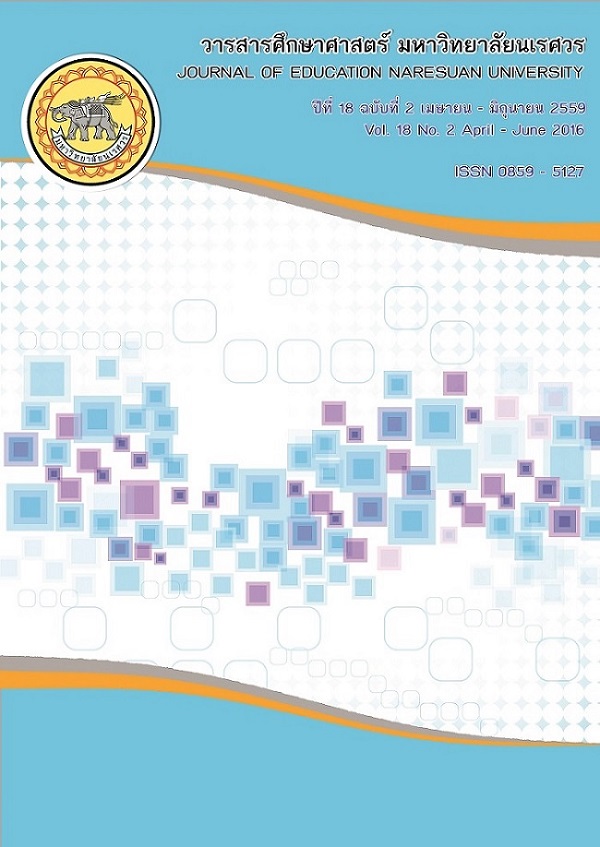การพัฒนาผลสัมฤทธิ์ทางการเรียนและความสามารถในการคิดแก้ปัญหา ทางวิทยาศาสตร์ วิชาชีววิทยา เรื่อง สิ่งมีชีวิตกับสิ่งแวดล้อม ของนักเรียน ชั้นมัธยมศึกษาปีที่ 4 ที่ได้รับการจัดการเรียนรู้โดยใช้ปัญหาเป็นฐาน
Main Article Content
Abstract
บทคัดย่อ
การวิจัยครั้งนี้มีวัตถุประสงค์เพื่อ 1) เปรียบเทียบผลสัมฤทธิ์ทางการเรียนวิชาชีววิทยา เรื่อง สิ่งมีชีวิตกับสิ่งแวดล้อม ก่อนและหลังการจัดการเรียนรู้โดยใช้ปัญหาเป็นฐาน 2) เปรียบเทียบผลสัมฤทธิ์ทางการเรียนวิชาชีววิทยา เรื่อง สิ่งมีชีวิตกับสิ่งแวดล้อม หลังการจัดการเรียนรู้โดยใช้ปัญหาเป็นฐานกับเกณฑ์ร้อยละ 70 3) เปรียบเทียบความสามารถในการคิดแก้ปัญหาทางวิทยาศาสตร์ ก่อนและหลังการจัดการเรียนรู้โดยใช้ปัญหาเป็นฐาน และ 4) เปรียบเทียบความสามารถในการคิดแก้ปัญหาทางวิทยาศาสตร์ หลังการจัดการเรียนรู้โดยใช้ปัญหาเป็นฐานกับเกณฑ์ร้อยละ 70 กลุ่มตัวอย่างที่ใช้ในการวิจัย คือนักเรียนชั้นมัธยมศึกษาปีที่ 4 โรงเรียนพนัสพิทยาคาร ภาคเรียนที่ 2 ปีการศึกษา 2557 จำนวน 41 คน โดยการสุ่มห้องเรียนด้วยวิธีการสุ่มแบบกลุ่ม เครื่องมือที่ใช้ คือ แผนการจัดการเรียนรู้โดยใช้ปัญหาเป็นฐาน แบบทดสอบวัดผลสัมฤทธิ์ทางการเรียน วิชาชีววิทยา เรื่อง สิ่งมีชีวิตกับสิ่งแวดล้อม และแบบทดสอบวัดความสามารถในการคิดแก้ปัญหาทางวิทยาศาสตร์ วิเคราะห์ข้อมูลโดยใช้สถิติพื้นฐานค่าเฉลี่ยเลขคณิต ส่วนเบี่ยงเบนมาตรฐาน และสถิติ t-test
ผลการวิจัย พบว่า
1. นักเรียนมีผลสัมฤทธิ์ทางการเรียนวิชาชีววิทยา เรื่อง สิ่งมีชีวิตกับสิ่งแวดล้อมหลังเรียนสูงกว่าก่อนเรียนอย่างมีนัยสำคัญทางสถิติที่ระดับ .05
2. นักเรียนมีผลสัมฤทธิ์ทางการเรียนวิชาชีววิทยา เรื่อง สิ่งมีชีวิตกับสิ่งแวดล้อมหลังเรียนสูงกว่าเกณฑ์ร้อยละ 70 อย่างมีนัยสำคัญทางสถิติที่ระดับ .05
3. นักเรียนมีความสามารถในการคิดแก้ปัญหาทางวิทยาศาสตร์หลังเรียนสูงกว่าก่อนเรียน อย่างมีนัยสำคัญทางสถิติที่ระดับ .05
4. นักเรียนมีความสามารถในการคิดแก้ปัญหาทางวิทยาศาสตร์หลังเรียนสูงกว่าเกณฑ์ร้อยละ 70 อย่างมีนัยสำคัญทางสถิติที่ระดับ .05
คำสำคัญ: การจัดการเรียนรู้โดยใช้ปัญหาเป็นฐาน, ความสามารถในการคิดแก้ปัญหาทางวิทยาศาสตร์
THE DEVELOPMENT OF LEARNING ACHIEVEMENT AND ABILITY IN PROBLEMS SOLVING THINKING IN LIFE AND ENVIRONMENT FOR GRADE 10 STUDENTS USING PROBLEM BASED LEARNING
The purposes of this research were: 1) To compare biology learning achievement in life and environment before and after learning using problem based learning, 2) to compare biology learning achievement in life and environment after learning by problem based learning with a criterion of 70%, 3) to compare the ability in problem solving thinking before and after learning using problem based learning, and 4) to compare the ability in problem solving thinking after used this approach with 70% as criteria. The samples in this research were 41 grade 10 students at Phanatpittayakarn School by using cluster random sampling, enrolled in the second semester of 2014 academic year. The research instruments consist of 1) the problem based learning plans, 2) the learning achievement test in life and environment and 3) the test of ability in problems solving thinking. The collected data were statistically analyzed by arithmetic mean, standard deviation, and t-test.
The research findings are as follows:
1. The students had biology learning achievement in life and environment was significant higher than before learning at the level of .05.
2. The students had biology learning achievement in life and environment was significant higher than 70 percent as criteria at the level .05.
3. The students had ability in problem solving thinking was significant higher than before learning at the level of .05.
4. The students had ability in problem solving thinking was significant higher than 70 percent as criteria at the level .05.
Keywords: Problem Based Learning, Ability in problem solving thinking
Article Details
The owner of the article does not copy or violate any of its copyright. If any copyright infringement occurs or prosecution, in any case, the Editorial Board is not involved in all the rights to the owner of the article to be performed.


